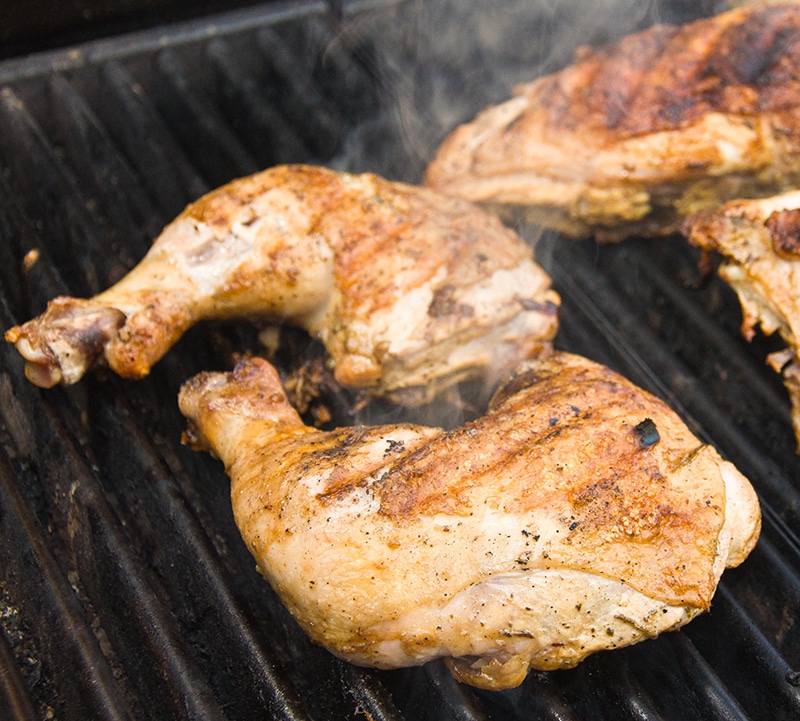Created by Bob Baker, once a professor of food science at Cornell University who was an expert in chicken, his Cornell chicken recipe has become so popular it is served all across Western New York. Below is my slightly modernized version of Dr. Baker's Original Recipe.
Serve with: your favorite pale ale.
Makes:
Servings: chicken quarters
Takes:
Ingredients
- 1 egg
- 1 cup vegetable oil
- 2 cups cider vinegar
- 2 tablespoons Morton Coarse Kosher Salt
- 1 tablespoon poultry seasoning or Simon & Garfunkel rub
- 1/2 teaspoon ground black pepper
- 2 broiler chickens cut into quarters
Notes:
About the salt. Remember, kosher salt is half the concentration of table salt so if you use table salt, use half as much. Click here to read more about salt and how it works.
About quartering the bird. The original recipe calls for cutting the birds in half, but I think it is better to quarter them since breasts and thighs cook at different rates, with the breasts being thicker, but less forgiving. You can overcook thighs and drums a bit and still have moist meat, but not breasts.
About the marinade. It is very close to a mayonnaise, so you can store the sauce in the fridge for a few days, even though there is raw egg, because the vinegar, salt, and cold will prevent salmonella from multiplying. Cooking it to 165°F, of course makes it perfectly safe. You can cut the recipe in half by discarding half the egg after whisking it.
Metric conversion:
These recipes were created in US Customary measurements and the conversion to metric is being done by calculations. They should be accurate, but it is possible there could be an error. If you find one, please let us know in the comments at the bottom of the page
Method
- Prep. In a large bowl, whisk the egg white and yolk together with a balloon whisk or a hand mixer. Add the oil and whisk until it gets thick, homogeneous, and a bright yellow, for about 2 minutes. A balloon whisk is the best tool for this job since the wire strands really do a good job of emulsifying (mixing together) two ingredients that don't want to mix, one oil based, the other water, but a fork will do in a pinch. Now whisk in the vinegar and salt. This makes it a brinerade, a combo brine and marinade.
- Stab the chicken skin several times with a fork or knife so the fat can get out when cooking. This will help make the skin crispy. Marinate/brine the chicken for 3 to 24 hours in zipper bags in the fridge. You can do this in a bowl or pan, but you need more marinade than if you use zipper bags. Every hour or so, turn the meat a bit so all surfaces get well coated.
- Fire up. Set up the grill for 2-zone cooking. Try to get the indirect side in the 225°F (107°C) range. If you're in a hurry, you can take it up to 325°F (163°C), but I prefer low and slow. Sprinkle the rub and black pepper on all sides of the meat.
- Cook. Place the chicken over the indirect zone and close the lid. Every 5 to 10 minutes baste with the marinade in a dabbing motion rather than a painting motion, being careful to not wash off the rub, turn the chickens on both sides, and move the ones closer to the heat away and the ones away closer.
- Cook the chicken for about 60 to 90 minutes until the internal temperature of each part is 150°F (65°C)and stop basting. The baste is contaminated and we want the final searing step to pasteurize the surface of the meat. Exact time will depend on how thick the meat is, and how often you basted. Then move them over the hot direct heat side of the grill, skin side down, lift the lid, and crisp the skin without burning it for 10 to 15 minutes. Flip and heat for about 5 minutes more. This step is important to finish the cooking of the meat, crisp the skins, and make sure everything is pasteurized since raw egg can contain salmonella. When the skin is crisp and the temp is 165°F (75°C), take the meat off. Even if it is a bit red in there when you cut in, it is safe at 165°F (75°C). You cannot judge a chicken's safety by the color of the juices! When cooking chicken you must use one of the fine new digital thermocouple thermometers available nowadays to make sure your poultry and other foods are cooked properly for taste and safety.
- Serve. Serve the chicken immediately alongside your favorite side dishes.
